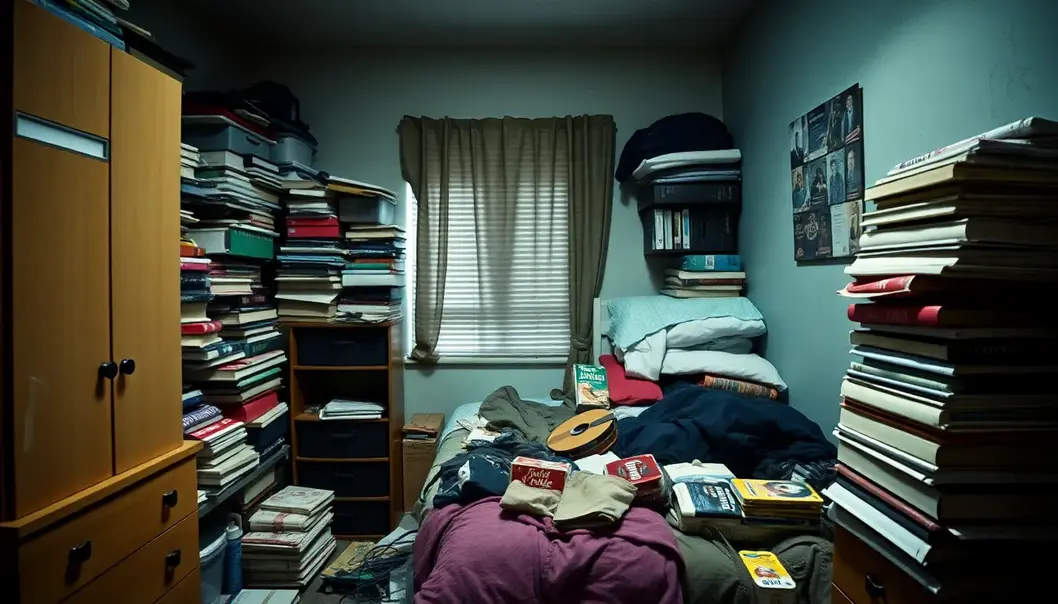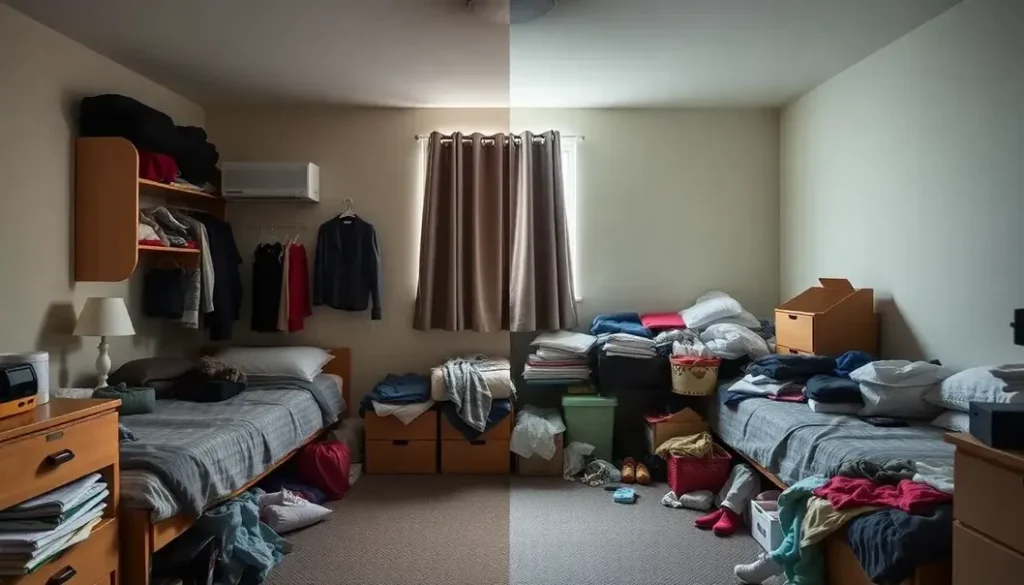College dorm living can be an unforgettable chapter in the book of life. Sharing a room or flat with strangers often leads to lifelong friendships. However, not all roommates are destined to become best pals. For some, the experience transcends quirky habits and harmless differences, venturing into realms of genuine horror and hilarity. Whether it’s a flatmate with a bizarre penchant for collecting moldy food or someone who turns your shared space into a 24/7 party zone, every college student faces the potential for a roommate nightmare. Read on for some astonishingly true testimonies of flatmates from hell, and gain a deeper appreciation for a harmonious home life.
The Hoarder in Room 202

In the first few weeks of sharing a flat with Ryan, his penchant for odd trinkets seemed harmless. A few novelty mugs here, some eclectic posters there—it added character to our otherwise bland student accommodation. But soon, this quirk escalated beyond mere idiosyncrasy, evolving into an all-consuming obsession that turned Room 202 into a labyrinth of clutter.
Ryan’s hoarding journey began with harmless excursions to local flea markets. What initially were occasional small purchases soon became truckloads of “treasures.” Old typewriters, non-functional antique clocks, stacks of yellowing newspapers—all piled high against our living room walls. The avalanche of items grew each week, transforming our shared space into a chaotic storage facility resembling a forgotten museum exhibit.
Living with a hoarder impacted my daily life in unexpected ways. The dwindling space meant fewer areas to relax or study. Attempting to reach the sofa required a perilous, almost acrobatic negotiation around precarious stacks of old vinyl records and outdated gadgets. The constant presence of clutter was suffocating, its oppressive weight seeping into both the physical and mental realms of my existence.
The sheer volume of possessions didn’t just clutter our flat; it cluttered my mind. I found my thoughts drifting to worries about fire hazards and pest infestations, instead of focusing on coursework. Studying at home became nearly impossible. My grades started to slip as I spent more time at the library or local cafes, desperately seeking spaces free from Ryan’s overwhelming collection. The stress of navigating this mess began to take a toll on my mental health, injecting an undercurrent of anxiety into what should have been an adventurous time in college.
Our utility bills soared, largely because Ryan’s appliances overflowed from every plug socket like a tangled web of electrical jungle. Meanwhile, arguments about cleanliness became commonplace squabbles, often sparked by my frustration at not even having space in the kitchen to prepare meals. Yet, attempts to address the issue with Ryan were met with defensiveness. He didn’t understand, or perhaps refused to acknowledge, that his passion for collecting was spiraling into pathological territory.
In a bid to reclaim some semblance of normalcy, I researched strategies to cope with hoarding behaviors. Understanding and patience were key, the articles suggested. Communication was crucial. But applying these solutions was challenging. Ryan’s denial of the severity of his hoarding problem left little room for compromise.
The turning point came one day upon returning from class. Our flat, a ticking time bomb of debris, succumbed to a minor water leak. The minor incident quickly escalated as the water absorbed into stacked newspapers and crates, resulting in a ruined mess. Faced with this visual evidence of his habit’s consequences, Ryan had no choice but to confront the reality of the situation.
We spent the next weekend sorting through the wreckage, Ryan willing for the first time to part with some of his treasures. With the urgency of the situation spurring us on, progress was finally made. Though our living arrangement remained strained, these efforts brought relief, hinting at the possibility of a more bearable coexistence.
Taking the time to address issues of space and shared ownership can prevent scenarios from escalating to crisis points. Those days in Room 202 turned out to be a lesson in patience, understanding, and the complexity of interpersonal dynamics in shared living quarters. They serve as a cautionary tale for students stepping into the realm of shared accommodations, and perhaps a reminder that sometimes, less is indeed more.
The Party that Never Ends

Living with a party animal isn’t just about enduring loud music and boisterous laughter—it’s about surviving the chaos they bring into every aspect of shared life. For Chloe, a diligent chemistry major devoted to decoding complex organic compounds, her flatmate Justin’s endless socializing was eating away at her peace and productivity bit by bit.
Amidst her constant efforts to maintain focus on her demanding coursework, Chloe found herself troubled by the incessant thrumming of bass that seeped into every crevice of their flat. Justin was the social nucleus of their college—an affable persona whose gravitational pull drew everyone, from the dorm next door to the new students who had just arrived on campus. The result? Their flat turned into a clockless club, where nights blended seamlessly into days.
Chloe’s academic performance started to flounder. Late-night parties left her sleep-deprived—that precious REM cycle shattered by echoes of unknown voices. Her grades, once sparkling, began to tarnish, mirroring the mess in their shared kitchen that never saw a dish washed since the semester began.
Her social life, too, fell victim to this unwelcome party culture. Friends hesitated to visit, scared away by the prospect of finding themselves at an unplanned rave. Chloe felt increasingly trapped, a prisoner of someone else’s party.
Faced with a relentless tide of revelry, she knew she had to devise a solution. Diplomatic talks bounced off Justin’s carefree demeanor like water on glass. He seemed oblivious to the toll his parties took on others. It required more tactical planning.
First, Chloe approached the problem creatively by appealing to Justin’s social side. She suggested a compromise. Chloe proposed restricted party nights—just once a week, while Friday nights could be cathartic noise-fests. The plan appeared reasonable, yet it failed spectacularly. Justin stood firm, obstinate in his pursuit of perpetual joy.
After months of futile negotiations, Chloe knew a showdown was inevitable. Armed with evidence of failing grades and mounting stress, Chloe approached their landlord. The strategy was risky, potentially escalating tensions, but it was Chloe’s last stand. She presented her case with clarity and urgency, highlighting how the uninterrupted noise breached the rental agreement’s stipulated quiet hours.
To her relief, the landlord was sympathetic, having been a student once himself. Supported by formal warnings, he laid down the law for Justin—a mandate he couldn’t ignore unless he wished to face eviction.
The transformation was almost magical. The notorious party pad became a haven of tranquility. Though occasional gatherings persisted, they were now confined to weekends, restoring the peace Chloe once craved. In this newfound quiet, Chloe reconnected with her studies and repaired her social circles. She even taught Justin the art of compromise, knitting a delicate détente in their shared collegiate adventure, one that provided life lessons more enduring than any textbook theory.
Final words
Navigating college life with challenging flatmates can test even the most patient among us. From cluttered chaos to non-stop parties, these stories show the resilience and creativity students muster to cope and adapt. Learning to assert boundaries and communicate effectively are lessons that serve well beyond college. Remember, these horror stories aren’t universal, and sometimes poor roommate situations can lead to stronger personal character and even bizarre but lasting friendships.
Ready for harmonious living? Find your perfect college roommate match with our incredibly accurate roommate pairing service today!
Learn more: https://www.collegeroomies.com/find-your-match
About us
College Roomies offers a sophisticated roommate matching service. Our algorithm considers lifestyle preferences, living habits, and personalities to pair students with compatible roommates. Make your shared living experience enjoyable, peaceful, and mutually beneficial, turning potential roommate horror stories into friendships.

